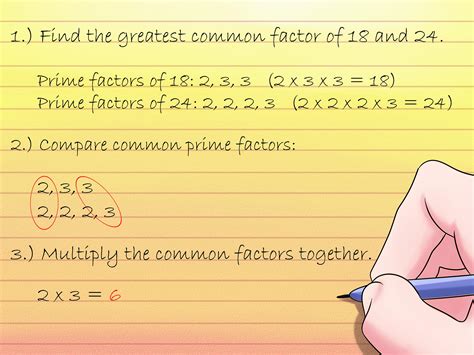How to Find the Greatest Common Factor (GCF)
Finding the greatest common factor (GCF) is a fundamental skill in mathematics with applications ranging from simplifying fractions to solving algebraic equations. This guide will walk you through several methods to efficiently determine the GCF of any set of numbers. Understanding GCF is crucial for various mathematical operations, and mastering these techniques will significantly enhance your problem-solving abilities.
Understanding Greatest Common Factor
Before diving into the methods, let's clarify what the GCF actually is. The greatest common factor (GCF) of two or more numbers is the largest number that divides evenly into all of the numbers without leaving a remainder. For example, the GCF of 12 and 18 is 6 because 6 is the largest number that divides both 12 and 18 without leaving a remainder.
Methods for Finding the Greatest Common Factor
There are several effective ways to find the GCF, each with its own advantages depending on the numbers involved.
1. Listing Factors Method
This method is best suited for smaller numbers. Simply list all the factors of each number and then identify the largest factor common to all.
Example: Find the GCF of 12 and 18.
- Factors of 12: 1, 2, 3, 4, 6, 12
- Factors of 18: 1, 2, 3, 6, 9, 18
The common factors are 1, 2, 3, and 6. The greatest of these is 6. Therefore, the GCF of 12 and 18 is 6.
2. Prime Factorization Method
This method is more efficient for larger numbers. It involves breaking down each number into its prime factors and then multiplying the common prime factors raised to the lowest power.
Example: Find the GCF of 24 and 36.
- Prime factorization of 24: 2 x 2 x 2 x 3 = 2³ x 3
- Prime factorization of 36: 2 x 2 x 3 x 3 = 2² x 3²
The common prime factors are 2 and 3. The lowest power of 2 is 2² and the lowest power of 3 is 3¹. Therefore, the GCF is 2² x 3 = 4 x 3 = 12.
3. Euclidean Algorithm Method
This is a particularly efficient method for finding the GCF of two numbers, especially larger ones. It involves repeatedly applying the division algorithm until the remainder is 0. The last non-zero remainder is the GCF.
Example: Find the GCF of 48 and 18.
- Divide 48 by 18: 48 = 2 x 18 + 12
- Divide 18 by the remainder 12: 18 = 1 x 12 + 6
- Divide 12 by the remainder 6: 12 = 2 x 6 + 0
The last non-zero remainder is 6. Therefore, the GCF of 48 and 18 is 6.
Applying GCF in Real-World Scenarios
Understanding GCF is vital in various practical situations:
- Simplifying Fractions: Finding the GCF of the numerator and denominator allows you to reduce a fraction to its simplest form.
- Dividing Quantities: Determining the GCF helps in dividing quantities evenly into smaller groups.
- Solving Algebraic Equations: GCF plays a crucial role in factoring algebraic expressions.
By mastering these methods, you'll be well-equipped to tackle GCF problems confidently and efficiently, improving your mathematical skills in various contexts. Remember to choose the method that best suits the numbers you are working with.
